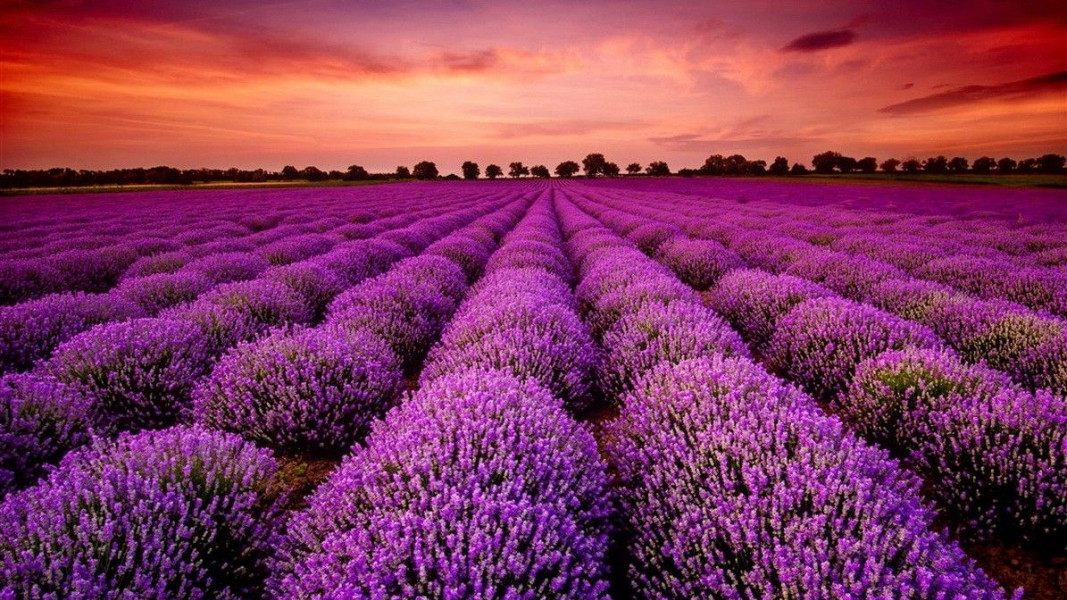Lavender Origins
Its name comes from the Latin word lava, which means washing, because the ancient Romans added the colors of this plant in their baths because of its freshness and pleasant smell. Lavender originates from the Mediterranean region. As a wild plant, it is found in southern France, the coastal Alps, eastern Spain, Italy and North Africa.
The countryside of southern France is a region known for its vast fields of lavender plantations grown for the perfume industry. In North America, the perennial shrub is popular mainly for its colors and aroma and serves to enrich any landscape because of its beauty and ability to withstand heat and drought.
In the garden, lavender can serve as a decoration, surrounding with its aroma and beauty each path, and can be pruned in the form of a low threshold. If the soil is difficult to cultivate, only a few shrubs of the plant will give the yard an amazing view. Lavender is also a wonderful accent to any herb garden, as its unique gray-green leaves contrast not only with its own colors, but also with all kinds of green herbs and other plants.
In fact, lavender grows just as well in artificial soil. In warm regions, it grows even better in pots, taking advantage of better drainage and air circulation.
Sowing lavender
In regions with mild winters, the best time to sow is autumn so that the plant can develop a healthy root system before the hot summer weather dries it out. Spring sowing can be successful if you are sure that the young plants will be watered regularly until they stabilize. Therefore, we recommend early spring, around the beginning or end of March, depending on weather conditions.
Site preparation
Lavender grows in well-drained soil or one to which you have added sand to allow drainage. The seedlings are ready-made roots, which are planted at a distance of 40 cm from each other. To improve the drainage process, plant lavender in raised beds or at the highest points in the garden.
Diseases and pests
When lavender is planted in well-drained soil with a suitable climate, the chance of disease occurring is minimal.
If, however, light yellow spots appear on the leaves and stems of your plants, simply uproot the diseased roots and burn them so that they do not spread to healthy plants, even if they have only been a few leaves.
Root rot is another of the most common problems of lavender plants. It is caused by fungi that form in moist soil. The only way to prevent it is to ensure good drainage of the soil, which, as we said, is extremely important for this plant. If the plants wither or dry out, it is best to remove them and destroy the affected roots.
Pruning of Lavender Plant
Lavender is a perennial plant that lives about 15 years and needs pruning while still young. If it is not treated by the second year of sowing, it is likely to begin to acquire a woody appearance, which results in fewer and healthier stems and correspondingly fewer flowers.
Another year after sowing the lavender bushes, remove the new growth, including the stems with flowers. Shape the plant into a spherical shape. Don't worry about aggressive pruning - lavender grows quickly and may be able to double in size each year during its growing season.
In the second year, prune the young shoots in early spring to encourage flowering. Prune again in the fall, removing the flowers and reshaping the bush.
When the plant is three years old, it is considered mature and it is enough just to pick its flowers and possibly again to slightly improve its spherical shape.
Protection
If you decide to grow lavender in pots, it should be protected in winter, because in the pot the soil is a bit colder than the soil in the garden.
Move the pot to the warmest and sunniest side of the house;
Wrap the pot in cling film or other material to protect the plant from the wind;
If the winter is really cold, wrap the pot with a blanket at night.
Medical properties and application of lavender
Lavender is most widely used in cosmetics and aromatherapy. The herb is known for its honey yield - from 1 decare of plantations, bees collect from 22 to 40 lb of honey. Lavender is also used as a spice in cooking, being one of the constituent units of "Herb de Provence" - a famous mixture of spices in France. It has been used in folk medicine since ancient times. Today the beautiful flower is used in homeopathy.
Cures headaches
It is said that Queen Elizabeth I drank lavender tea because it had a positive effect on her frequent headaches. To soothe headaches, drink a cup of lavender tea or apply lavender oil on your forehead and temples with massaging movements, avoiding the area around the eyes.
Reduces stress
In Japan, research has shown that linalool, a substance found in lavender, calms nerves, relieves accumulated tension and helps reduce stress. The substance is contained in the aroma of lavender flowers, so you can just sow lavender in your yard and enjoy its fragrance and beauty. To get rid of stress in everyday life you can also scatter lavender around the room, make a fragrant bath with petals of the plant or with lavender oil and relax.
Heals emotional irritations
As mentioned, linalool molecules are contained in the aroma of flowers. They stimulate the nerves and balance the central nervous system. This makes lavender a natural and natural remedy against stress, panic, depression and fatigue. To take advantage of this action of the plant, use lavender oil for massages all over the body, especially around the spine and to the neck, do inhalations with it or just drop a little on your hands and inhale it.
To summarize with a few quick tips:
- Continuous sun for at least 6 hours a day!
- Excellent drainage - likes rocky and sandy soils.
- Air circulation - keep the area around the roots clean of creeping plants or weeds.
- Prune annually, leaving 0.4-0.8 in of light green leaves. Do not cut the stems. Do this around Valentine's Day or after the coldest part of winter.
- Water once a week, being careful not to drown the plant.
- Remember: warm, dry and high!

